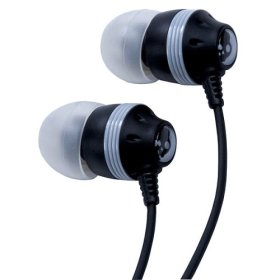My iPod stock headphones (the newer sleek version) sound pretty good. However, on a recent airplane trip it was obvious that I needed a better solution that cranking my iPod to max volume to hear the movie I was watching.
Most of the time I tend to listen to music at very reasonable volume levels, loud enough to block the background hum in the office – but not so loud I won’t hear the phone or someone talking to me. Once you’ve sunk enough cash into really nice sound equipment (home theater), you start to think seriously about protecting your ability to enjoy it over the long term. Thus, earplugs are my friend at rock concerts, club events (the few I still go to) and hockey games. In my youth I did enough damage to my hearing that I’d rather avoid losing it entirely later on in life.
Initially I was looking for active noise cancelling headsets, but their relative cost and the mixed results people have had resulted in my looking at some of the in ear canal headphones that provided passive noise reduction (they are effectively ear plugs with speakers). Several of my friends have the Bose system and swear by it, so I suspect if you can talk yourself into the cost and the ‘big can’ style is ok then it is a good solution.
After digging around the web, I came across the Skullcandy Ink’d ear buds. These seem to fit my requirements of in ear headphones, with some amount of noise blocking – but the real thing that sealed the deal was the cost: $13 (The Source was having a 1/2 price scale). It turns out BestBuy also carries these and they are often on sale for $15.
One negative is that the earphones are not marked left and right. I read somewhere, and it seems to be true from my listening, that if you look at where the earphone wires join up, there is a small plastic block with skullcandy written on it. The words on the plastic block are on the front, so if you follow the wires up – you can figure out left and right. Some users have sorted out left and right, then marked one with a dab of nail polish – I may do the same at one point, but these will mostly get used on airplanes where fidelity is already somewhat compromised.
Compared the to stock earphones, I noticed immediately that I could hear a background hiss when I plugged them into my iPod. Checking with some other headphones I have, I believe that this background hiss is actually being masked by the stock headphones. This is actually annoying enough that I would not want to use these at the office or any relatively quiet listening environment.
On the positive side, these are great on an airplane. They work almost as well as earplugs, but let me listen to music at a much more reasonable volume level (still louder than I would in a quiet environment). You know you’re still on a plane, but even with the music off – they provide a reasonable amount of sound reduction. The bass is actually pretty good as well – much better than the stock ear buds.
Some reviews of the Ink’d complained about fit, and squeeky noises from the plastic inserts. I haven’t really experienced any problems with them at all. However, at one point I may try the hack of using a leather punch to modify a foam earplug to fit these as a potential upgrade.
Overall, I’d have to consider myself very pleased with the purchase. For a very modest price, I got myself what I consider a great set of headphones for airplane travel.


